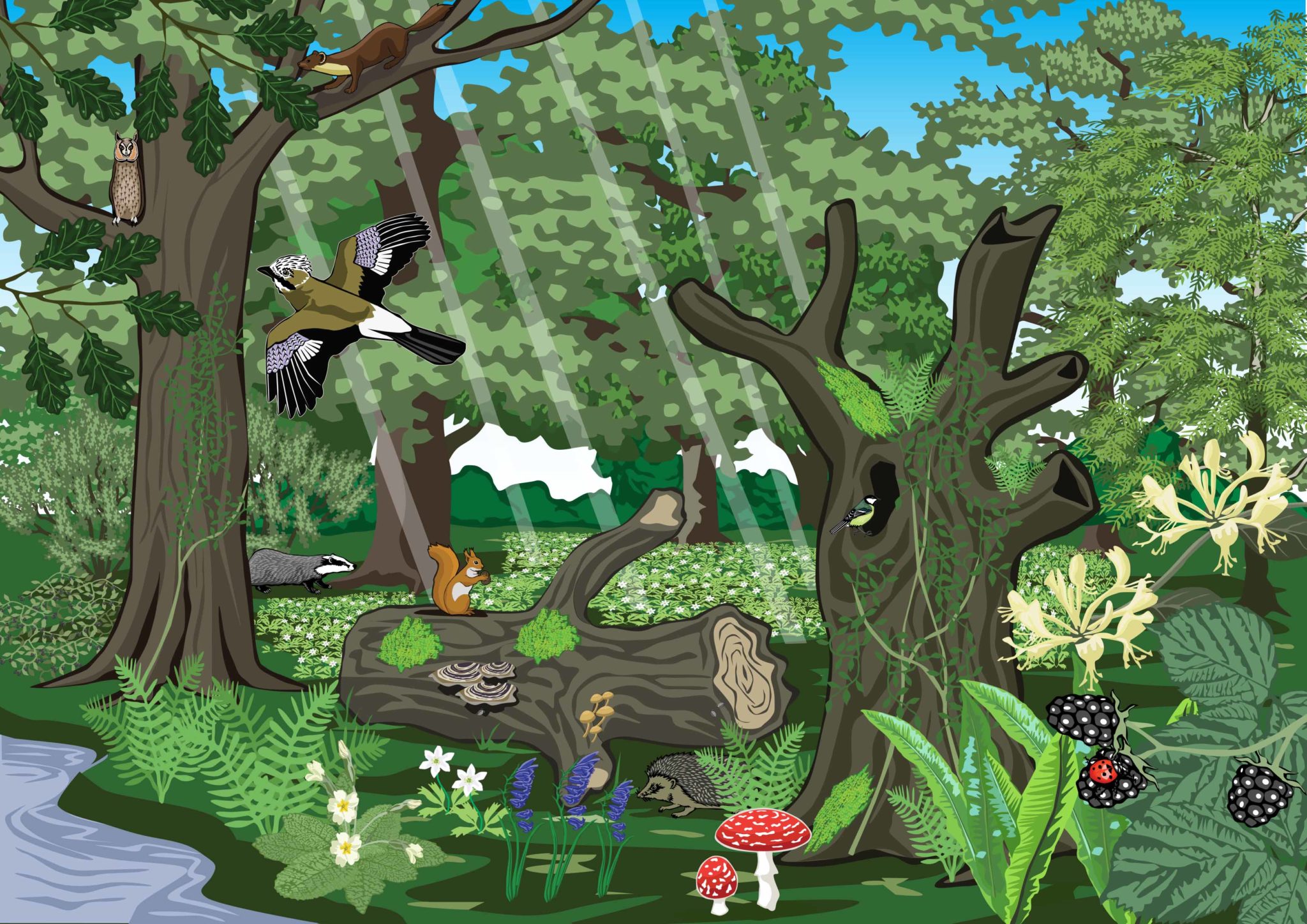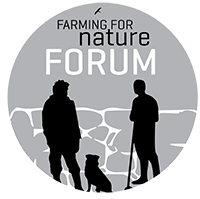Woodlands
Native Irish woodlands comprise a diverse mix of trees (e.g. oak, ash, hazel, holly, .) and contain a wealth of plants (e.g. bluebell, bugle, primrose, wood anemone, wood avens), animals (e.g. pygmy shrew, red squirrel, badger, bat, pine marten) and fungi.
With woodland covering only 11% of the land area, Ireland currently has one of the lowest tree covers in Europe. Furthermore, most Irish ‘woodlands’ and ‘forests’ are in fact non-native plantations: less than 2% of Ireland is considered to be under native woodland. These fragments of native woodland are extremely valuable to the native Irish biodiversity that has co-evolved with them. As such, it is vital to protect our native woodlands wherever they occur, as well as to find creative ways to increase native woodland cover across Irish landscapes.
Actions on the Farm
WHAT’S THERE ALREADY?
The first step in improving the value of any farm habitat is to understand what’s currently living there. Understanding what animals and plants are living in your woodland will help you to tailor your managment actions. This is especially important in terms of recognising any damaging invasive species (e.g. laurel or rhododendron) or rare or protected species (e.g. red squirrel, pine marten, Kerry slug or lesser horseshoe bat), as they may require specific management. Visit our resources section to find out more about identifying common, rare or invasive species in your woodland.
RETAIN AREAS OF DEAD WOOD: EITHER STANDING OR LYING
- Standing dead wood is an important nesting site for cavity-nesting birds.
- Dead wood in semi-shaded conditions is good for fungi and invertebrates.
- Did you know that standing and lying deadwood decompose in opposite ways? Standing deadwood rots from the inside out, whereas lying deadwood rots from the outside in! As such, these two types of deadwood provide for two different suites of specialist insects and fungi.
HAVE A VARIETY OF TREE AGES
- Having trees of different ages gives the woodland a natural structure and allows natural regeneration (new trees to emerge) over time.
- Coppicing (see below) can be used to thin dense areas of similarly aged trees and allow light to reach the smaller plants on the ground.
- When planting new trees, ensure you use native species and preferably those sourced from locally grown stock.
- Where possible, allow woodland to regenerate naturally.
- Avoid clearfelling large areas – always retain some woodland areas when harvesting timber so that escaping wildlife has somewhere to go!
COPPICING
- Coppicing is a type of woodland management where areas of suitable woodland are cut back to nearly ground level before being allowed to regrow. This allows a harvest of timber to be taken without the need to replant. Sections of woodland can be cut each year on a long rotation (e.g. for woodchip, biomass, stakes, walking sticks, or even for use in thatching hurdles!), while allowing other areas to regrow. This means there are always some areas available for wildlife.
RETAIN WET AREAS AND A DIVERSITY OF NATURAL FEATURES
- A mix of sunny, shaded and sheltered streams benefits wildlife in woodlands. Wet areas and ponds are also great for insects. Temporary pools can be used by frogs and insects.
- Do not remove natural debris such as fallen logs as these are important for wildlife.
- Having a diverse range of structures including glades, buffer zones along rides (pathways) and woodland edges, ground vegetation, shrubs, and a diverse tree canopy will encourage a wider range of wildlife.
- Consider adding these areas into new and existing woodlands where possible.
MAINTAINING OPEN AREAS
- Low intensity grazing can maintain open areas such as glades, provided that newly planted trees/shrubs are protected by fencing or by thick thorny-scrub (fencing can be temporary, e.g. length of fence-life – perhaps 15 years).
- Long-term grazing/browsing of unprotected seedlings/saplings can affect woodland structure and prevent natural regeneration.
- Deer fencing may be needed to allow the woodland to naturally regenerate without grazing pressure.
CONNECT YOUR WOODLAND TO OTHER HABITATS
- As with any habitat, connectivity is important. It is harder for wildlife to move through fragmented habitats. Try and link your woodland to other wildlife areas such as hedgerows, ponds and wet grassland using buffer strips or by planting additional hedgerows.
- If planning a new woodland, consider how to connect it to existing habitats ahead of planting.
MANAGING WOODLAND RIDES
- Rides are tracks through the woodland for people and machinery. Vary the width, shade and cutting regime of woodland rides to enhance biodiversity.
- Cut the plants along the rides in small segments on a rotational basis as needed.
- You can create a variety of habitats by cutting the grassy verges of the track or buffer zone every 1-3 years, about 25% of the small shrubs every year on a rotation, and then coppicing the larger shrubs and small trees at the woodland edge on a piecemeal rotation every 8-20 years.
- To avoid negative effects on invertebrates, coppicing and mowing should be carried out in autumn or winter.
MANAGING BUFFER ZONES
- The buffer zone between the edge of your woodland and the other habitats is an important area for wildlife.
- Buffer zones create a gradual transition from woodland trees at the edge to smaller trees and shrubs and finally giving way to grassland. Edge grassland can be rotationally cut in a similar method to the woodland rides as explained above.
CREATE AND PROTECT HOMES FOR WILDLIFE
- Bats and birds may roost and nest in your woodland, particularly in old or hollow trees. Protecting such areas from destruction or disturbance will benefit wildlife.
- Adding new bat and bird boxes can encourage more of these species into your woodland. However, natural habitats will always be better than manmade – try to create natural habitats (e.g. standing deadwood) wherever possible.
- Bat boxes should be placed at least 4m high in sunny, sheltered locations away from artificial lights. Place in a location where there is at least 1m radius of free space around the box to allow the bats an easy flight path.
- Bird boxes should be in sheltered, sunny positions away from other nest boxes or bird feeders. Each species of bird has different nest box requirements. It’s important, in particular, to research the right height to install the box and to create the perfectly sized entrance hole!
- Detailed advice on installing bat and bird boxes can be found at the below links.

For more information on how to farm for nature, search by
SECTOR HABITAT SEASON FAQS
FURTHER RESOURCES EMAIL US ANY SUGGESTIONS

